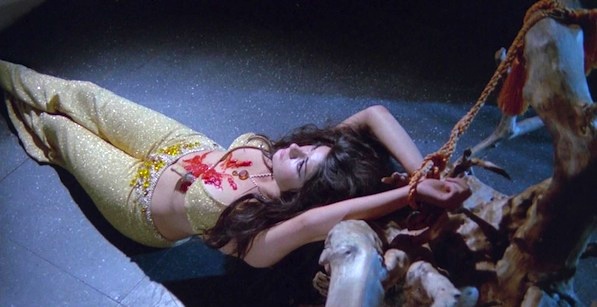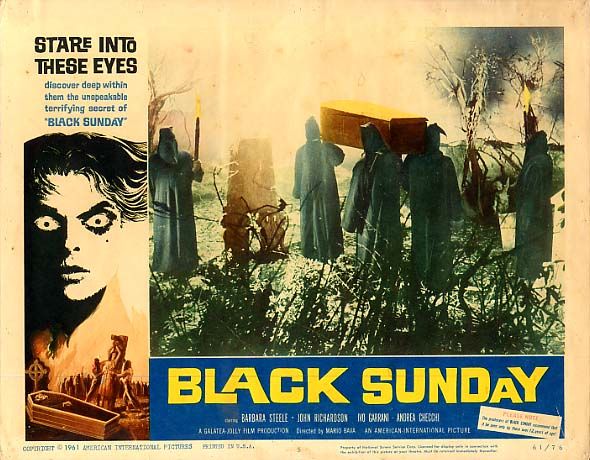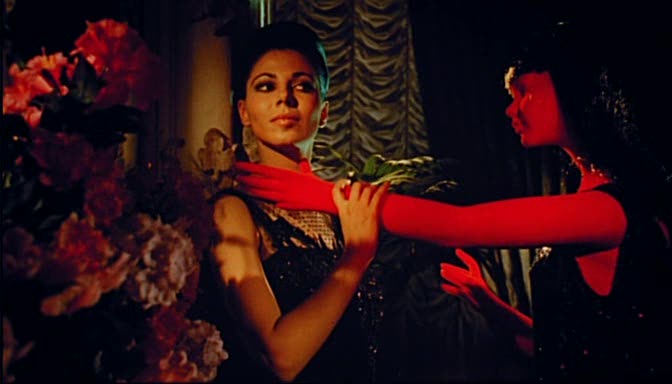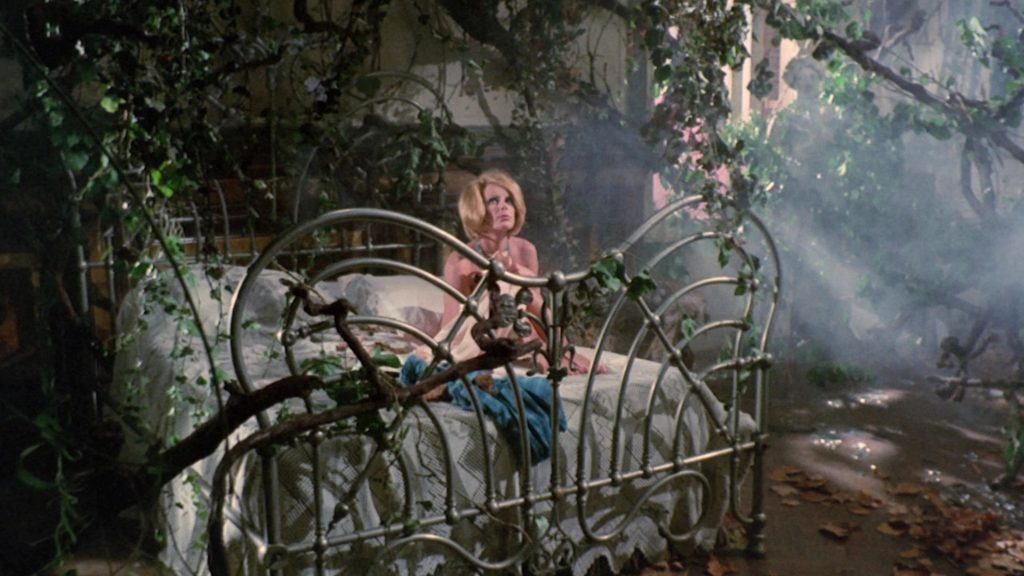Brigitte Bardot never made a horror film, but in a roundabout way she had considerable impact on the genre. Before she caused an international sensation in 1956’s And God Created Woman, exportable European movie goddesses had mostly been of the remote, mysterious, “exotic” type—Garbo and Dietrich rather than the corn-fed, busting-out-all-over likes of Betty Grable or Jane Russell. But Bardot’s sexuality was so blatant it trumped even contemporary Marilyn Monroe to a degree: If MM most often played the giddy ninny oblivious to her own seductive power, BB never left such self-knowledge in doubt.
The enormity of “Bebe’s” popularity naturally triggered a frantic search for other bombshells, from Sweden (Anita Ekberg) to England (Diana Dors) to Austria (Senta Berger—anywhere between the Atlantic shores and the Soviet bloc. Meanwhile, the surprise success of Britain’s Hammer horrors (notably the Dracula/Frankenstein films with Christopher Lee and Peter Cushing) from 1957 onward, as well as a gradual loosening in censorship toward sexual and violent content, resulted in a new, and newly lurid, generation of scary movies from Europe—a place hitherto seldom very interested in that genre.
While beautiful dames menaced by maniacs and monsters had always been a movie staple, earlier horror had doled out deaths more or less equally to male and female characters. That began to change, however, amidst the more overtly sexed-up screen environment of the 1960s. With men the primary target audience, it made perfect sense that such grisly thrillers should be populated with gorgeous, scantily clad (or, as time marched on, naked) women. Sometimes they were cast as murderesses, witches and vampires—but most often as scream-queen victims. Where the screen Eurobabe had once risked little danger beyond the racy misunderstandings of sex farces, now she was subjected to endless mortal peril from which her odds of survival were slim to none.
Late Italian horror maestro Mario Bava, while hardly the most lascivious director toiling in sixties’ and seventies’ Eurosploitation, certainly knew the box-office value of a pretty face and figure—or at least his producers and financiers did. Beyond being among the best, most influential horror films of their era, Bava’s exercises in that genre provide a representative parade of Continental beauties running, screaming and expiring their way to screen terror immortality.
After two decades as a cinematographer, Bava made his official directorial feature debut with 1960’s Black Sunday. That sleeper success did a great deal for him, for his hitherto little-known imported star, and for Italian horror. The star was uniquely haunted-looking British actress Barbara Steele, who played both a vengeful dead witch and her lookalike latterday descendent, and who for better or worse would be largely typed as a scream queen for the rest of her career.
Three years later Bava kicked another career into overdrive and created what’s considered the first screen “giallo” (a term originally applied to cheap paperback thrillers) with The Evil Eye a.k.a. The Girl Who Knew Too Much. This time it was Italian beauty Leticia Roman who was launched into a brief international stardom as a Roman tourist terrorized after she accidentally witnesses a killing.
That same year Bava made one of his most perverse films, The Whip and the Flesh, with Christopher Lee as an aristocrat so wicked he returns from the grave to continue his S&M romance with sister-in-law Daliah Lavi, a voluptuous Israeli starlet. More important in the annals of horror, however, is the movie Bava made next: Blood and Black Lace, arguably the template for the slasher genre. Its convoluted but eye-poppingly gorgeous color murder mystery is set in a ritzy couture fashion house where someone is eliminating models (and anyone else who gets in the way) in order to recover an incriminating diary. With its dwindling roll call of beautiful women (led by elegant Hungarian Eva Bartok) and suspenseful set pieces, it announced Bava as a major stylist.
A later giallo, 1970’s Five Dolls for an August Moon, is similarly beautiful to look at and near-impossible to follow plot-wise—but then its real focus is on simply placing very pretty people (at least the female ones) in even prettier settings, including some arrestingly “mod” interior decor. Unfortunately, someone is once again killing them off in this unofficial remix of Agatha Christie’s “Ten Little Indians.” Among the glamorous babes here are Maltese-Italian former Miss France Edwige Fenech, a cult film favorite, and Iva von Furstenberg—who married a an actual prince at age fifteen and was born (take a deep breath now) Virginia Carolina Theresa Pancrazia Galdina Prinzessin zu Furstenberg. In the clip below, the pervasive cheesecake is offset by some rare beefcake as body-built Howard Ross nee Renato Rossini and she face a most unpleasant postscript to their night of illicit lust.
Few of these stunning ladies had lengthy careers—then as now, youth and beauty comes cheap and are easily replaced in the film industry—nor were many widely known outside Europe. One exception was Elke Sommer, a blonde Berliner who had some success in 1960s Hollywood. By the Me Decade, however, she’d re-crossed the Atlantic and was starring in two (or three, depending how you count them) Bava horrors. In 1972’s Baron Blood she’s a miniskirted if rather mature architecture student whose career-girl snippiness—movies of that era tended to paint “liberated women” in unflattering terms—pales very quickly when she faces any old false scare.
After the titular evil aristocrat (Joseph Cotten) is raised from the dead, however, she faces plenty of surprises that really merit her screaming response. Baron Blood is not exactly prime Bava, but their next collaboration proved both one of the director’s most beautiful and most beleaguered projects. In 1973’s Lisa and the Devil, she plays a tourist lured into a strange Spanish villa where she and several strangers (including veteran Eurobabes Sylvia Koscina and Allida Valli) are subjected to all kinds of hallucinatory frights, seemingly at the hands of a man who may be the Devil himself (Telly Savalas, then TV’s Kojak). In its original form, this morbid maze was a striking phantasmagoria—horror cinema as a dream state barely troubled by story logic.
But after a festival premiere, distributors shied away from the film’s near-abstract nature, so in desperation its producer shot cheesy new footage cashing in on The Exorcist‘s recent smash success. “Demonic possession” scenes of Sommer spewing pea soup and such were awkwardly cut in while the beauty, mystery and fragile narrative were cut out from what finally emerged as The House of Exorcism. It took a long time for Lisa to be seen in its intended state, particularly in the U.S. Today you can watch both, and marvel at the wild differences between them—not to mention the hot mess one made of the other.







